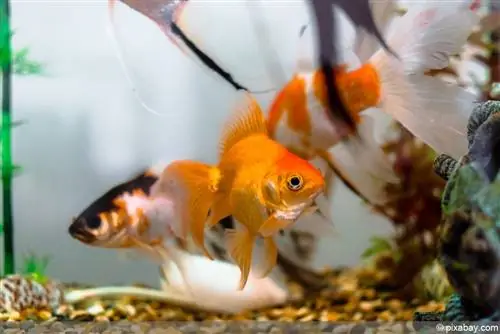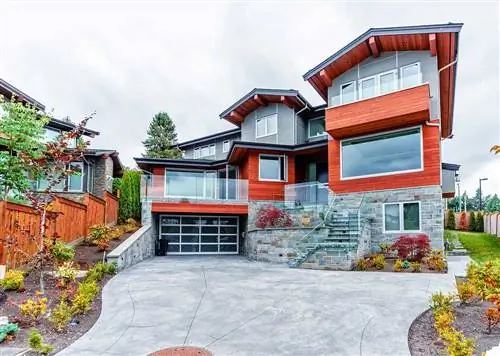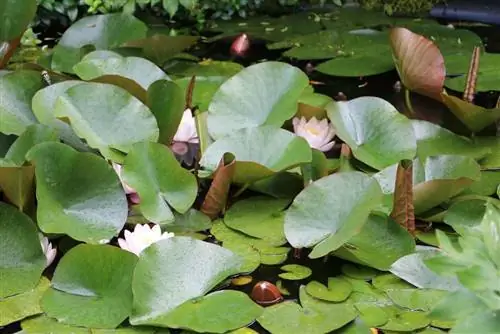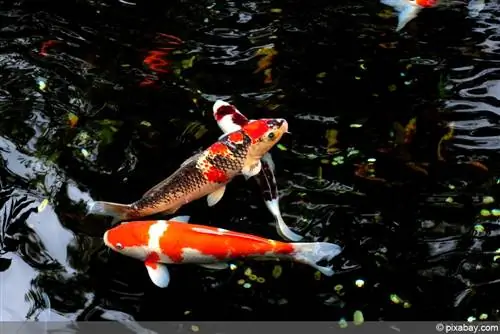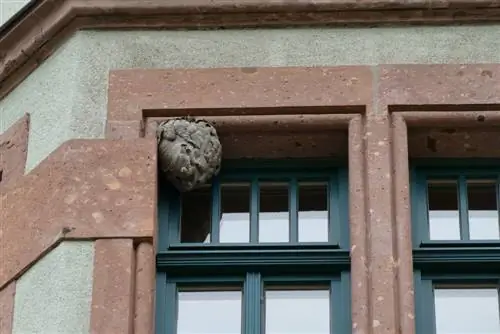- Author admin [email protected].
- Public 2023-12-17 03:39.
- Last modified 2025-01-24 12:45.
Anyone who has a garden pond also wants to enliven it. Goldfish are often the first choice because they are comparatively undemanding and can be easily recognized even in deeper ponds due to their striking color. The coloring that gives them their name also makes them popular aquarium fish. No matter where they swim, their needs and special characteristics - such as life expectancy - must be known in order to keep them.
Life expectancy
How old goldfish grow in ponds and glass aquariums does not depend on the basic type of accommodation - instead, conditions of keeping and care determine life expectancy. If these are species-appropriate, the strikingly colored fish can live around 25 years. Individual cases are said to have even reached the proud age of 40 or more.
Unfortunately, the reality is often different and the animals die after just a few months or years. With the right knowledge, it is very easy to create the optimal conditions for the goldfish. How old goldfish can live depends on the following factors:
- Stress and strain, for example from breeding or frequent transport
- Water quality and temperature
- Size and design of garden pond or glass aquarium
- Feeding
- Protection
- Adapted hibernation
Water
Goldfish are very tolerant when it comes to water, but of course it still has to meet certain requirements. If you want to prevent illness and give your goldfish a long life, pay attention to the following points, which represent optimal values:
- pH value between 7 and 8
- Total hardness 12 to 18°dH
- Carbonate hardness 10 to 14°dH
- Ammonium less than 0.1 mg/l
- Nitrite less than 0.1 mg/l
- Nitrate less than 25 mg/l
- Carbon dioxide less than 20 mg/l
With an appropriate water test from a specialist retailer, the values can be determined and then adjusted accordingly through water treatment. Alternatively, a water analysis can be carried out in a pet store.
Temperature
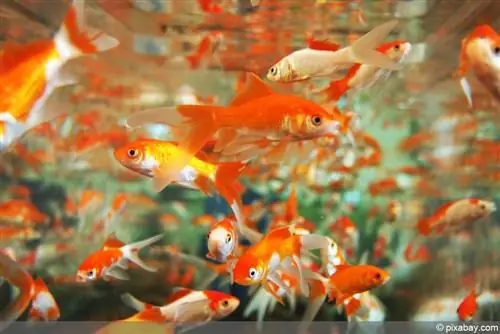
Goldfish are also very tolerant of the water temperature. This can be between 4 and 30°C. However, 18 to 24°C is optimal in summer and 6 to 14°C in winter. Veiltails and other, more exotic cultivated forms require more warmth and are therefore only partially suitable for the garden pond, as they require at least 12 or even a minimum temperature of 15°C.
Breeding forms
Goldfish, with the scientific name Carassius gibelio forma auratus, are available in various breeding forms. Small variants, veil-tails and highly bred forms such as lion's head, oranda or ryukin are recommended for the aquarium. These can also be kept in the garden pond in summer, but on the one hand they are less robust and on the other hand they require more warmth. They are also comparatively slow swimmers, which can be disastrous in a garden pond.
" Ordinary" goldfish for the garden pond, on the other hand, are less sensitive and, under the right conditions, can also be overwintered in the garden pond without heating - but they usually reach larger dimensions of up to 35 centimeters. You should therefore seek professional, competent advice when making your selection.
Pond
If goldfish are to be kept in the garden pond, it must be designed and equipped accordingly. As a rule of thumb, the deeper the pond and the greater the amount of water, the easier it is to maintain and the easier it is to create optimal conditions. The water quality is also more stable and the goldfish can stay in their current comfort zone.
If you want to integrate a pond into your garden and keep goldfish in it, you should make the garden pond as large and deep as possible. In addition, attention must be paid to the following points:
- Approximately a third of the pond should be in shade to provide varying surface temperatures and protection
- No blazing midday sun
- Introduce aquatic plants as protection and food
- Use natural soil, such as gravel or earth
- For overwintering in the pond, provide at least a depth of 1.5 m
- Introduce filters
Aquarium
At least 75 liters should be planned for one fish so that the aquarium is still easy to care for the goldfish and the water quality remains easy to regulate. One of the most common mistakes is to underestimate the space the goldfish need. This promotes illness and drastically reduces life expectancy.
In addition to sufficient water volume, the fish also need aquatic plants in the glass aquarium, natural soil for feeding and a suitable filter. Heating is not necessary, but the location should be chosen carefully. Some protection is needed, especially in well-heated, poorly insulated or attic apartments.
Surprisingly, not in winter or because of the cold, but in summer and when the water temperatures are too high. Goldfish can withstand temperatures of up to 30°C, but if these occur more frequently or last longer and if there is no compensation, their lifespan is shortened. The aquarium should therefore be frost-free but under no circumstances should it be located directly next to a heater or in front of a south-facing window. Even the warmest room in the house is unsuitable.
Food
If aquatic plants and organisms are available to the goldfish, they do not need daily feeding. However, this is usually only the case in a species-appropriate garden pond. Food tablets, flakes or granules should be used daily in the aquarium - but very sparingly.
Experience has shown that it is beneficial to feed several small amounts a few minutes apart. This makes it easier to estimate how much the goldfish really eat in a timely manner. Leftover food can very quickly have a negative impact on the water quality, which is why it is best not to occur in the first place. A “well-intentioned” handful of food can have devastating consequences. It is better to feed regularly but in small doses.
Filters and cleaning
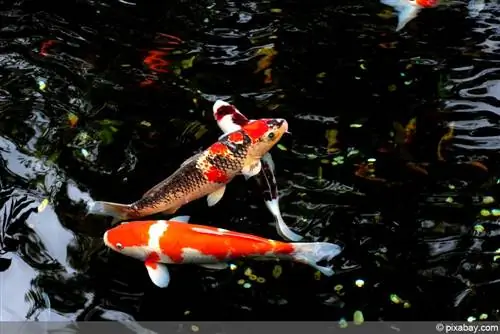
The goldfish should be treated to a filter in both the garden pond and the glass aquarium. Variants with UV light, which can also kill algae, have proven successful in garden ponds. By circulating the water and filtering impurities, maintenance costs can be saved.
Partial water changes and the suctioning of debris is reduced. However, these measures are still necessary if necessary.
Protection
The protection of goldfish is mainly but not only important in the garden pond. In the pond there are cats, herons but also falling leaves and other pollution from which the animals need to be protected. Nets over the pond, a well-chosen location and obstacles at the edge of the pond as well as sufficient pond depth have a preventive effect.
Leaves and dirt can be removed using a quiver on the one hand and filters on the other. Nobody in the aquarium has to be afraid of the hunger of herons, but cats and incoming dirt and foreign bodies are certainly problematic. A suitable cover can help here.
Wintering
When overwintering below 12°C, the goldfish do not need any food, but they should be kept frost-free at all times and a temperature of at least 4°C must be maintained. A depth of at least 1.5 m is required in the garden pond. Apart from this, the following points are important:
- Do not allow the water surface to freeze, prevent freezing with Styrofoam plates
- Do not give oxygen
- Filter can be switched off
- Do not undertake stressful measures such as cleaning or similar
- Increase the water temperature slowly, even in the aquarium
Tip:
Lowering the temperature and stopping feeding are good for the goldfish and can increase their life expectancy.
Conclusion
Keeping goldfish is easy as long as a few simple basic rules are followed. Anyone who knows the needs of the fish can implement them very easily and will enjoy the animals for many years.

